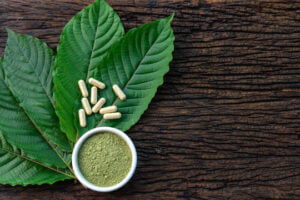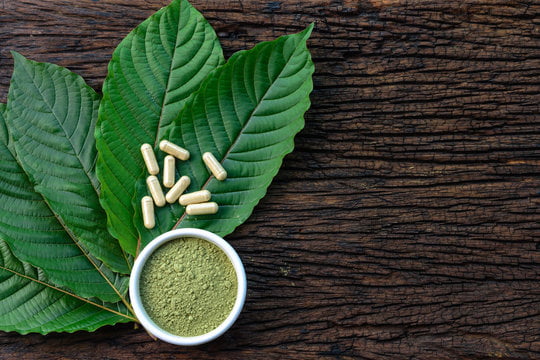
Free Standard Shipping on orders over $49 and Priority on orders over $100! Dismiss
Skip to contentIntroduction
For centuries, a tropical evergreen tree found in the rainforests of Thailand, Malaysia, and Indonesia has been enjoyed and respected for its myriad uses. This tree features distinctive leaf varieties identified by veins of white, green, and red coloring, each of which yield unique effects on both the body and the mind.
This tree is known as kratom – a name spoken more and more often in recent years. Whether you’ve just heard of kratom or want to learn more details about its origins and uses, we’ve written this comprehensive kratom primer with your interests in mind. Now, let’s take a closer look at kratom’s history, various strains and consumption methods, along with some great tips for beginners!
Kratom Origins & History
Kratom (Mitragyna speciosa) is an evergreen tree indigenous to the tropical regions of Southeast Asia, found in countries like Thailand, Malaysia, Indonesia, Myanmar, and Papua New Guinea. The peoples of these areas have used the leaves of the kratom tree in their traditional practices, incorporating it into their lives by either consuming the raw leaves or brewing them into teas and other beverages.
Kratom’s unique properties have become better understood over the centuries, and it’s popularity has gradually spread throughout the region. Farmers cultivate and harvest kratom crops to meet rising demand from local consumers looking to enjoy its use.
While kratom has maintained a niche presence in these regions, the product has gained more worldwide exposure and interest in recent decades as global markets have expanded. Now, kratom communities are international – its commercialization has spread across the world in the 21st century.
Yet, despite its traditional heritage and widespread usage, kratom still maintains an air of mystery and misinformation, especially in Western cultures. Fortunately, increasing research efforts and open discussions have brought a deeper, science-based understanding of kratom and its uses.
The Kratom Plant
The kratom tree is a member of the Rubiaceae family and is closely related to other plants like coffee and gardenia. One of its key botanical connections is the presence of alkaloid compounds, including mitragynine, which is primarily responsible for kratom’s unique properties.
The leaves of the kratom tree contain dozens of additional alkaloids and compounds that contribute to the varied effects consumers report.
One of the more recognizable characteristics people use for identifying kratom’s different varieties is the color of the veins on the leaf stems and undersides. This vein color is most often used to categorize the most popular kratom strains:
Vein color provides a basic visual identifier for strain types, but there’s a lot more going on inside the complex alkaloid chemistry of kratom. A range of factors like growing conditions, techniques for harvesting, and how the leaves are processed play major roles in the effects of any given kratom batch.
Consumption Methods
Kratom users consume its leaves in a number of ways after they’ve been harvested from kratom trees. Native cultures from the Southeast Asian countries mentioned above commonly chew the unprepared leaves to experience their effects. More popular internationally, kratom leaves go through a drying process before consumption, which allows them to be preserved for longer periods.
The dried kratom leaves can be brewed into a kratom tea similar to how ordinary tea leaves are prepared. Additionally, dried kratom leaves can be ground into a fine powder that is far more versatile for consumption. This powder is often packaged into capsules for convenient ingestion or mixed into various foods and beverages.
As kratom consumption has grown in popularity over the years, users have found a huge range of ways to ingest and enjoy it. At KratomGala.com, we proudly provide kratom products in numerous forms, including:
In other words, however you want to experience kratom, there’s a product out there to suit your needs. And remember, no matter the type of kratom product you come across – whether it’s leaves, powders, capsules, teas, concentrates, etc. – do some research on the product’s specific composition and potency before you decide the appropriate servings for personal use.
Popular Kratom Strains
While kratom strains are often broken down by vein coloring (white, green, and red), they’re also known by the region they’re cultivated. Some of the more popular examples you’ll encounter include:
It’s important to note that cultivation, drying methods, and other specific techniques in processing have more impact on specific strains than the locations they’re grown in. Always do your research!
The Worldwide Kratom Community
As kratom has reached more mainstream visibility, large communities of kratom consumers have emerged both on the Internet and in local markets.
Social media groups, online forums, as well as in-person meetings allow kratom enthusiasts to discuss their personal usage experiences and share advice. Stores are opening in even the most unexpected rural markets that specialize in kratom sales.
It’s clear that kratom continues to grow in popularity worldwide. This is particularly beneficial both for users and for the scientific community researching its viability and effectiveness.
Beginner Tips
For anyone intrigued by kratom and wants to try it themselves, there are some general tips that can help newcomers get started:
If you’re just starting or want to sample a brand new strain of kratom, be sure to start with a lower dosage amount first. Everybody’s metabolism handles compounds differently, so it’s important to gauge your personal response at milder levels before increasing your intake.
More experienced kratom consumers recommend you explore a single strain at a time rather than blending multiple varieties and taking larger amounts when first starting out. This way, you’ll isolate the distinct effects of each type of kratom and determine for yourself what works best.
Take care to track your experiences with different strains and dosage levels to reveal and record critical insights about your own response to kratom over time. A wise consumer of any product can make more informed decisions over time based on how they respond to the product at different intervals of use.
Deciding on your ideal kratom regimen requires a good deal of personal experimentation. What works for your friends and neighbors may create different effects for you, so it’s important to keep an open mindset when it comes to your kratom journey.
Ultimately, you should approach kratom like you would anything else: with wisdom, moderation, and a commitment to safely learning your own complementary relationship with the product. Whatever effects it may or may not have can truly only be revealed through your own intentional experience.
Kratom & You
Hopefully, this guide has provided a thorough introduction to kratom’s origins, history, varieties, and popularity. With this knowledge in mind, you should be able to understand kratom and its uses from a more balanced, responsible perspective.
Whether you want to consume it as a raw leaf, dried powder, capsule, tea, concentrate, or otherwise, you should have a better grasp on how to accomplish it. If you want to develop a responsible relationship with kratom, you’ll need to craft your own open-minded yet disciplined approach of self-discovery.


Twenty years from now you will be more disappointed by the things that you didn’t do than by the ones you did do.
- Mark Twain Tweet


Disclaimer: The content provided on KratomGala.com is for informational purposes only and does not constitute medical advice. The products listed on our site have not been evaluated or approved by the Food and Drug Administration (FDA). They are not intended to diagnose, treat, cure, or prevent any disease or medical condition. The effectiveness of these products has not been confirmed by FDA-approved research. We strongly advise consulting with a healthcare professional before using any product, especially if you have pre-existing health conditions or concerns. These products are intended for use only as botanical specimens and are not for sale or use by individuals under the age of 21. Kratom, particularly the compounds Mitragynine and 7-Hydroxymitragynine, may interact with brain receptors similarly to opioids, which could potentially lead to habit formation, dependency, and withdrawal symptoms. Please use responsibly and adhere to the manufacturer’s guidelines.
Kratom & 7-Hydroxymitragynine: Products containing Kratom or 7-Hydroxymitragynine are not for sale or use by individuals under the age of 18, or 21 where applicable. Certain states and localities have specific restrictions or bans on Kratom and 7-Hydroxymitragynine, including but not limited to ALABAMA, ARKANSAS, INDIANA, RHODE ISLAND, VERMONT, and several counties within various states. We do not ship internationally, and we do not ship to military bases. ID verification is required for certain states, including Florida, Virginia, and West Virginia. It is your responsibility to understand and comply with your local laws regarding the purchase and use of these products. KratomGala.com and its affiliates assume no responsibility for the improper use of any product sold through this site.
